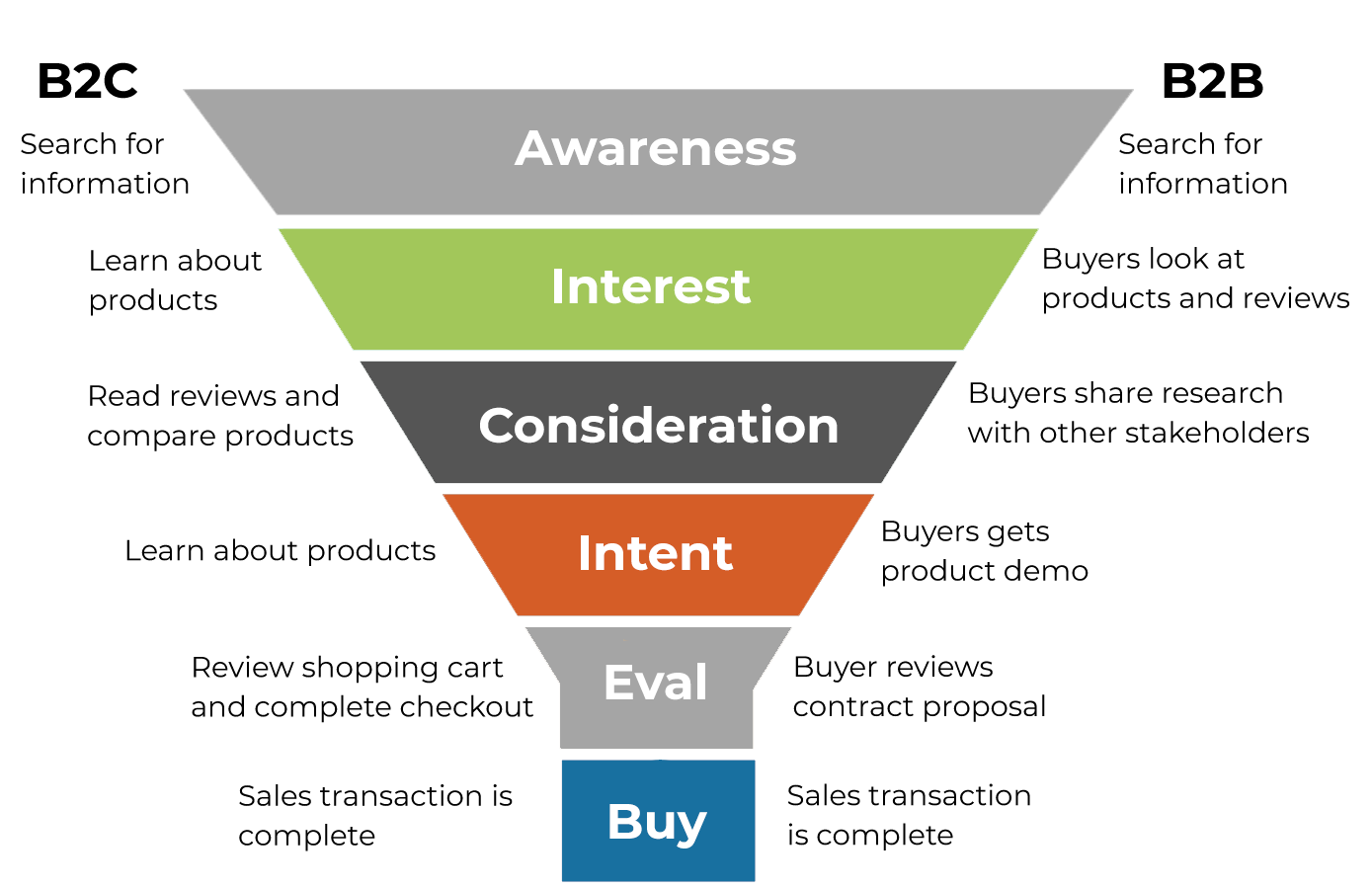Leaders in B2B marketing and sales are always looking for the next new strategy that will offer them an advantage over their competitors, especially when it comes to increasing income for their company. In marketing and sales, the importance of using intent data to target better and engage potential customers is stressed constantly.
The best intent data combines first-party data with data from third parties, making it possible to generate possibilities for genuine activation and engagement at every stage of the buyer’s journey. This information may be used at every point in the sales and marketing process, from initial lead generation and customer profiling to final purchase decisions and ongoing retention and satisfaction.
In addition to increasing the potential applications for intent data, recent developments in data collecting, enrichment, and activation technologies are allowing for a more concrete contribution to revenue targets.
What is Intent Data?
Intent data refers to digital users’ online content consumption habits gathered via various means. By processing the data correctly, B2B marketers may get actionable insights that can be included in inbound content, remarketing campaigns, and follow-up tactics. When making an online inquiry, decision-makers leave a data footprint. Although only some research will be directed towards satisfying an immediate requirement at work, the kind of information they click on and the amount of time they spend on it provide clues to their goals.
A digital user’s interest in the goods your organization sells may be gauged by monitoring their consumption patterns of topic-driven material when buyer intent data technologies are in use.
Reasons why Intent Data is valuable
In B2B marketing, intent data helps sales teams anticipate prospects’ needs and close deals more effectively. This makes sense if the flaws of the standard lead-scoring system are considered. Sales personnel manually award points according to established standards when a potential customer is found. These algorithms ignore the “purpose” of the lead, making them nothing more than just educated guesses. As a consequence, their output may be subpar.

In contrast, a lead scoring model’s efficacy will increase when it considers the buyer’s intent based on the most recent data. This model is superior to others in its ability to forecast when a customer is most likely to make a purchase.
How are Intent Data obtained?
Internal and external sources of intent data collection are possible. Internal data collection is the compilation and analysis of information obtained inside an organization, such as information from its website, mobile app, customer chats, and other marketing and sales channels. The following are examples of internal data collection sources:
- Using Google Analytics you may see who is visiting your site, where are they from, and for how long they stayed on your site.
- With integrated analytics for social media, you may learn a lot about your customers and how they interact with your business, thanks to the data gleaned from your social media marketing efforts.
- Hotjar provides records of user sessions on your website or mobile app, allowing you to see how visitors engage with your site or app. It also facilitates the administration of on-site surveys to gain insight into site users’ motivations.
- The information from conversations between your company and its clients.
- In the same vein, you may do research on intent data by gathering information from other sources, either independently or with the help of a third party. Using social listening technology is an efficient technique to obtain external data independently. It helps you hear what your ideal customers are saying to one another. Salesforce, HubSpot, and Adobe are just some reputable places where you can purchase access to customers’ behavioral data.
- Last but not least, you may get intent data from third-party sources that do not collect and gather data from their clients but instead compile data from various other sources.
Track down serious buyers who visited your website and acted quickly
Recognizing the signs of your leads’ purchase intent is crucial for making a sale. There needs to be more than just having a fantastic offering; you must also be prepared to close the deal when your lead is hot. Having your sales crew strategically located is essential.
With the help of apps, you can pinpoint the precise moment your leads are ready to purchase. You may create specialized feeds that pick up high-quality leads when they visit specific sites (like pricing or demo page.) In this way, you may gauge a lead’s level of enthusiasm before ever reaching out to them.
Internet users who are still browsing would want to take their time deciding

This contrasts with the browser on the other end of the spectrum. A browser business worker may check out your site next week. Another worker might review installation logs and download many case studies a week later. Another week passes, and a third worker requests a demo. You’re holding a browser in your hands. In other words, this is a lead that has to be cultivated slowly but surely. People sending these signals are interested in what you have to give but are not quick to buy it.
After learning from your purpose data that you are dealing with a browser, you may handle the situation patiently. Do not bombard them with queries or product details. A single email may offer a trial extension and instructions for a demonstration. However, they should be greeted warmly and invited for more engagement whenever they’re ready, with no pressure or inquiries about when that could be. They’ll be grateful they weren’t hurried, and when they’ve finished their internet investigation and are ready to purchase, they’ll be pleased to find out that you value their time.
Speed up your sales process
Sales teams may use intent data to make their last push of the year more effective and to start building their pipeline for the next year earlier than their competitors. Intent data allows you to guess what prospects think and keep tabs on who they connect with before they’ve even signed up for a webinar or downloaded a white paper.
Using intent data, you can eliminate the guesswork from relationship development and cold calling by customizing your communication with prospects based on their seniority, purpose, purchasing stage, and familiarity with the competitive landscape. Plus, if your data includes details down to the level of individual contacts, your sales staff will have a more nuanced grasp of the dynamics of the purchasing teams of your prospective customers and be able to tailor their outreach better to them.
Find chances to make further sales, both up and across
The cost of acquiring a new client is sometimes far higher than keeping an existing one. When you spend thousands of dollars on a new client, you want to do everything possible to keep them as customers. Apps allow you to track how active customers use your site, allowing you to optimize your upselling and support efforts. Each client’s activity on the site, including the pages they visit and how long they stay on each, may be monitored by account managers through feeds explicitly created for them.
Individualized communication
Personalizing your communication with supporters can boost the results of your campaign. If your sales staff knows what your leads are investigating, they will be better prepared to convince them to open your email or pick up the phone. You may improve your marketing efforts, save time on tracking down unqualified leads, and increase the quality of the leads you pursue by learning more about your prospective consumers’ purchasing habits.

By incorporating B2B intent data into a larger marketing plan and supplementing it with your in-depth knowledge of your target audience, you can increase the likelihood that qualified leads will see your message.
Learn what information your active transactions need
Most salespeople have yet to learn what kind of research their prospects do on their websites before and after meetings. As a result, you’ll have to make educated guesses about potential customers’ tastes based on the information already available online. Sometimes you need to have a discovery call to learn more. In doing so, you are wasting the time of both your leads and sales staff.
Apps provide a way to fix the problem. As a result, salespeople can observe which sites a firm visits, how long they stay on each, and even which blog articles the leads are reading.
Make adjustments to your sales approach depending on the actions of your leads
Discovering new leads and identifying the best ICP (Ideal Customer Profile) matches with intent data enables you to provide better services to prospective customers throughout the sales and marketing process. First, classify your leads as either bee-liners or browsers. In contrast to the deliberate speed of a browser, a bee-liner zips through their work. The way you develop these leads will depend on this differentiation. A bee-liner should be attended to with haste, but a browser should be allowed enough time to mull over their options.
Be prominent in the minds of potential buyers as early as possible
Your ability to reach out to prospective customers and convince them to purchase your solution is greatly enhanced if you know when they are researching it. The customer’s final decision between your product and the alternatives may hinge on the value you provide. The sales team may nurture a customer’s pipeline path and purchasing phase from beginning to end. Collecting the prospect’s intent data upfront may adapt the targeted communications better to their specific requirements.
Understanding the value of intent data for ABM efforts
Insights gained from intent data may be used to tailor a company’s approach to engaging B2B buyers. Use the information it gives to get practical knowledge about the purchasing habits of potential clients. The result is an increase in sales efficiency as marketers can hold in-depth conversations with the appropriate decision-makers at optimal times.
Marketers may tailor their strategies for engaging with different accounts by learning about their research and purchasing processes. Intent data has several potential applications in account-based marketing (ABM), the most important of which are mentioned here:
- Intent data may be used to prioritize and filter accounts, which can provide a score for each account.
- The finest chances inside an account are more likely to be pursued thanks to the sales strategy.
- Scoring leads based on the value of the accounts they are likely to convert into customers is called “lead scoring,” It involves correlating consumer behavior data with customer intent.
Stats on intent data can help you plan your B2B sales strategy
B2B marketers now have access to a handy analytics tool in the form of buyer intent data. It has altered our strategy for developing campaigns by allowing us to get leads from highly qualified, actively shopping consumers. The importance of intent data to salespeople is often underestimated. The following numbers illustrate how sales teams may use intent data to understand leads better and provide more relevant, timely solutions.

Over 40% of B2B sales executives utilize intent data to improve customer relationship management (CRM)
Working in sales for any time will teach you that the customer relationship management system (CRM) or sales database may get stale with old, outdated data points. There’s a limit to how many times you can email a prospect using the same value proposition. As a result, sales teams have started to include intent data in their CRM to get additional insights. Intent data follow your buyer’s actions and may also analyze more details like market share, spending habits, and company-wide activities. If the data can be fed into an analytics machine powered by artificial intelligence, then the computer can be used to infer the buyer’s purpose.
Half of all executives surveyed said intent data helps bring sales and marketing closer together
Revenue targets and key performance indicators (KPIs) motivate and monitor the efforts of both sales and marketing groups. By definition, the marketing department is responsible for gathering intent data, enhancing it, and passing it along to the sales department through leads. The communication established via this process aids in closing the gap and fostering accurate alignment between sales and marketing staff. To meet sales targets, marketing departments should focus on facilitating sales rather than just generating more leads.
When it comes to growing your company, why is Intent data the best choice?
If your company is considering using Intent data, you should also consider the following:
- Are the sales cycles lengthy or complicated?
While the benefits of intent-based marketing may be seen in any sales cycle, they shine during more extended, more involved purchasing processes. There may be more incredible difficulty in the getting-to-know-you and value-creation phases of the purchase process when a substantial barrier to entry, such as a high price point, exists. Knowing when and how to tackle these obstacles is made more accessible by having access to intent data.
- Do our marketing and sales efforts target a specific list of companies?
You may improve the effectiveness of your outbound campaigns by working with an intent data supplier to compile and continuously prioritize highly focused prospect lists for use in targeted, timely outreach. It may shorten the time it takes to close a transaction and save effort by identifying prospects who still need to be ready to engage. Intent marketing allows organizations to re-market to the prospects of their competitors based on the demands that the prospects have that the competitors may not be able to provide.
- To what extent do our current infrastructure and procedures let us use expanded Intent information?
To follow top prospects, collect data about buyers, and act on it. Most B2B companies that use the potential of Intent data have CRM software and marketing automation platform in place.
The B2B buyer path and associated intent data
The path taken by business-to-business customers has long piqued the interest of those working in marketing. Especially now, when everything is moving online, and B2B customers are more mobile than ever, customers have altered how they make purchases. Since sales staff are less influential on the buyer than they once were, providing them with high-quality content at every stage of the sales funnel is more crucial than ever.
Conclusion
Investments in intent data may provide the most significant returns when focus on improving first-party data precedes them. But it may grow exponentially with the help of reliable data suppliers who provide genuine intent data and the tools necessary to accelerate the data activation procedure. To guarantee that your data partners can help you speed up your pipeline, boost your close rates, expand your deals, raise your sales efficiency, and, ultimately, increase your top-line income by asking them key questions.
Find a provider that guarantees the largest and most comprehensive collection of intent data and insight to increase conversions at every stage of the buyer’s journey and sustain a steady flow of leads into the pipeline.




